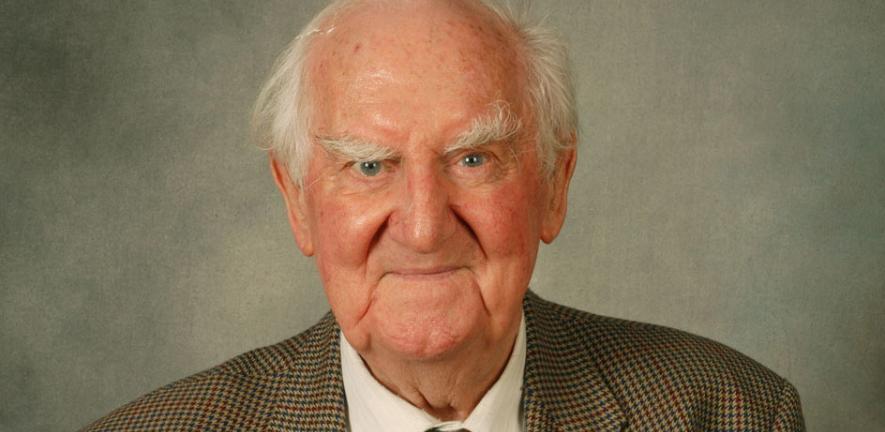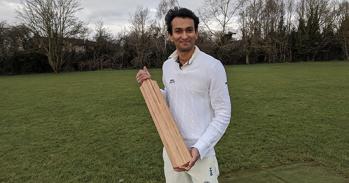
Head of Department of Metallurgy (1958-65), Master of Jesus College (1974-86), and Vice-Chancellor of the University (1977-79)
Head of Department of Metallurgy (1958-65), Master of Jesus College (1974-86), and Vice-Chancellor of the University (1977-79)
Alan was the most outstanding and influential Physical Metallurgist of the twentieth century.
Peter Hirsch
A tribute by Professor Sir Peter Hirsch FRS
Over a period of some 70 years the impact of Alan Cottrell’s scientific work on the basic understanding of materials and its practical application to engineering structures, his academic leadership and his role of Scientific Advisor to the Government has been immense.
After graduating in Metallurgy at Birmingham in 1939 Alan was put on war work, and was introduced to a serious problem of cracking of armour plating of tanks at electric arc welds, which he solved. This early experience no doubt influenced his lifelong interest in fracture and structural integrity.
Alan was made Lecturer in 1943 and in 1944 married Jean Elizabeth Harber, a marriage which lasted happily for 55 years. They had one son, Geoffrey in 1951, and much later adopted a daughter Ioana. It is said that one of his classic books Dislocations and Plastic Flow in Metals, published in 1953, was written during sleepless nights with baby Geoffrey.
Towards the end of the war Alan prepared a new lecture course “Theoretical Structural Metallurgy” (which formed the basis of another classic book he wrote at this time) in which he discussed the structure and properties of metals in terms of the behaviour of constituent atoms and electrons.
This course was very influential and ahead of its time. It contributed greatly to transforming a hitherto rather qualitative treatment of the subject into a quantitative and rigorous approach. Alan was a brilliant lecturer, able to convey quite complex phenomena in simple terms.
After the war Alan started research on the plastic properties of metals. In a series of penetrating and elegant, now classic, studies he showed inter alia how certain crystal defects called dislocations determined some important unique features in the ductile behaviour of structural steels, and how their interactions controlled hardening of metals by cold working. His contributions in this field are second to none.
Alan’s work contributed much to making the Birmingham Department famous as a leading centre for the science of metals.
Alan was given a personal Professorship in 1949 at the age of 30, and in 1955 was elected to The Royal Society at the early age of 35.
In 1955 Alan was invited by Monty Finniston to join him as Deputy Head of the Metallurgy Division at Harwell. He accepted because he expected to find problems there of national importance which fell into his field. One of his pioneering researches there, on neutron irradiated metals, led to a redesign of the fuel rods in Magnox Civil Nuclear Reactors.
On 10th October 1957 a reactor at Windscale caught fire and started a national emergency. It occurred during a gentle heating to anneal the damage in the graphite core. Unfortunately, the energy released in this process heated up the graphite so much that it caught fire. Alan set up a new laboratory in just two weeks and he and his team unravelled the problem and were able to give an assurance that the Magnox reactors would be immune to this self-heating effect.
In 1958 Alan accepted an invitation to become Head of Department of Metallurgy at Cambridge. He modernised the Department by bringing in new people (Robin Nicholson, Tony Kelly, Jim Charles, and later Graeme Davies) and new equipment, and by teaching the subject from the atomic point of view. He also started two new research projects, on field-ion microscopy, and on superconducting alloys.
His own researches focussed on brittle fracture of structural steel at freezing temperatures, responsible for many tragic accidents to ships and bridges, and secondly, with Tony Kelly, on the physics of fibrous composites. This led to the development of new materials such as fibreglass and carbon fibre.
Alan’s work on fracture identified a toughness parameter for a metal containing a crack, which was characteristic of the material, and which, when measured in a test piece, could be used to predict behaviour in a large structure. This represented an important advance in understanding and in ensuring structural integrity, and had an enormous impact in this field.
All these changes in teaching and research activities transformed the Department into a world-class institution. It has remained so ever since.
In 1964 Alan accepted an invitation to become Sir Solly Zuckerman’s Deputy in the Ministry of Defence. Although most reluctant to leave the Department and the University, he had become concerned with the need to invigorate British Manufacturing Industry with Scientific Technology, and felt that Whitehall was the place to do this.
Working on Dennis Healey’s defence review, Alan led tri-services studies on the problems, in particular the excessive cost, of a military presence in the near and far East. This led to the cancellation of the Government’s East of Suez Policy.
In 1966 he followed Solly to the Cabinet Office as Deputy Chief Scientific Advisor. There he tackled various problems with scientific aspects, including the brain drain, environment and pollution, the Advanced Passenger Train and the Torrey Canyon disaster, but efforts to transfer some government defence research funding to research in civil industry failed, because the Treasury was interested only in reducing research funding.
In 1971 Alan was knighted and became Chief Scientific Advisor. His position became complicated by the arrival of Victor Rothschild and his Central Policy Review staff.
A proposal to make the work of the Research Councils more related to National needs, while retaining their independence, led to the controversial “Customer-Contractor” principle. This involved relevant Government Departments appointing Chief Scientist Advisors to help them to commission research from the Research Councils, and transfer of some funds from the Research Councils to the Departments. Alan commented that this scheme attracted an enormous correspondence which rapidly filled his filing cabinet.
Alan was not very comfortable with the machinations of Whitehall politics. He played straight, and used his powerful intellect to make his case, however unpopular.
In 1974, in evidence to the Select Committee on Science and Technology, Alan expressed his concern about the integrity of the steel reactor pressure vessel, which is critical to the safety of the Pressurised Water Reactor, promoted by Walter Marshall, for our Civil Nuclear Programme. This caused quite a stir. Walter Marshall set up a High Level Pressure Vessel Committee which examined the issue in great detail.
In the early 1980s, following the Marshall Report, Alan said that he was now satisfied that a sufficiently robust safety case could be established. The report and Alan’s endorsement had a major impact on the Sizewell B enquiry and on getting Nuclear Installation Inspectorate approval, and led more generally to major advances in the requirements for ensuring the integrity of pressure vessels and other large safety critical structures.
In 1974 Alan accepted an invitation to become Master of Jesus College, Cambridge. He was glad to return full time to his family and to academic life. Alan had to supervise a major revision of the College Statutes and prepare for the admission of women. This proved a great success.
In 1977 he became Vice-Chancellor for two years. He was surprised by the amount behind the scenes work that was needed, dealing with grievances and settling disputes. There was a lot of entertaining that had to be done and the Chancellor, Prince Philip, stayed in the Lodge. Much of the responsibility fell on Jean, who managed it superbly and with much pleasure.
In 1986 Alan retired. He returned to the Department, and researched a new topic: The application of modern electron theory of metals to metallurgical problems, such as embrittlement of metals by certain impurities.
Alan mastered the quite difficult theory and published in 1988 an excellent book Introduction to the Modern Theory of Metals. This was followed by an impressive set of papers and the publication of a book on Chemical Bonding in Transition Metal Carbides
In early 1996 Jean fell ill with Parkinson’s disease. Alan looked after her full time, so that she could stay at home. Sadly, she died in 1999 and Alan was devastated, and only got through it by strong family support.
Alan was the most outstanding and influential Physical Metallurgist of the twentieth century. Through his pioneering researches, and as an educator, he has influenced countless students, scientists, and engineers over the years and will continue to do so. His papers and books are remarkable for their clarity. In his researches, he always knew what important questions to ask, and how to answer them. He had a brilliant intellect which he retained to the end.
Alan was a kind, gentle, and sensitive person, with a sense of humour, and very supportive of people. He loved his family and was proud of Geoffrey working on nuclear fusion, which Alan considered to be an important future energy source.
He was very eminent, but did not realise it, and was very modest. He received many awards and honorary degrees. At a Metal Society Conference in 1977 Alan received the Acta Metallurgica Gold Medal and commented that he was suffering from “medal fatigue”.
In 1996 he received The Royal Society Copley Medal, the highest award of the Royal Society. He was the first metallurgist to receive the medal since it was first instituted in 1731.
His life time achievement and impact have been immense, of which his family can be justly proud, and the rest of us can be grateful for.
Biography of the writer:
Professor Sir Peter Hirsch FRS
Emeritus Professor, Oxford University, since 1992
Educated Cambridge University
Lecturer and Reader in Physics, Cavendish Laboratory, Cambridge 1959-1966
Fellow of Christ’s College, Cambridge 1960-1966; Honorary Fellow 1978
Isaac Wolfson Professor of Metallurgy, Oxford University, 1966-1992
Chairman, United Kingdom Atomic Energy Authority 1982-1984
The Cottrell Appeal Fund
The Department of Materials Science & Metallurgy and the School of Physical Sciences of the University of Cambridge established a professorship in memory of Sir Alan Cottrell.
This work is licensed under a Creative Commons Licence. If you use this content on your site please link back to this page.



